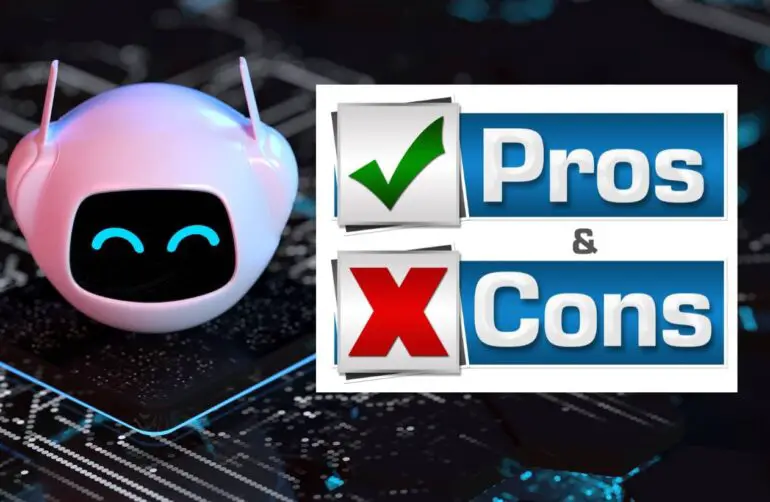Welcome to a journey through the intricate world of AI-generated content! Imagine a future where articles, stories, and even poetry flow not from the pens of humans but from the algorithms of computers.
This is no longer a realm of science fiction; it’s our reality today. AI-generated content is rapidly becoming a staple in industries ranging from journalism to marketing, transforming the landscape of content creation as we know it.
But what does this mean for us? As with any technological advancement, there are two sides to the story. It’s crucial to weigh the advantages against the potential drawbacks before fully embracing AI-generated content.
Understanding both aspects will help users and creators make informed decisions about integrating this technology into their workflows.
The structure of this blog post is designed to give you a comprehensive analysis of AI-generated content. We’ll define what it is and explore its applications across different fields.
Then, we’ll delve into the pros, highlighting how it can improve productivity, accuracy, and cost-efficiency.
However, every rose has its thorns; we’ll also discuss the cons, including concerns over originality, ethics, and bias.
Finally, we’ll share strategies to mitigate these drawbacks, ensuring that the benefits of AI-generated content can be enjoyed responsibly. So let’s embark on this exploration together!
What is AI-generated content?
In the realm of digital innovation, AI-generated content is fast becoming a game-changer across various sectors.
But what does this term really mean? Simply put, AI-generated content refers to material such as text, images, videos, and even music that is created by artificial intelligence algorithms rather than human beings.
This type of content has found applications in journalism, where it can churn out news reports; in marketing, where it crafts personalized ad copy; and in creative writing, offering everything from poetry to novel drafts.
The Science Behind AI Content Creation
At the heart of AI content generation lies natural language processing (NLP), a branch of AI that focuses on the interaction between computers and human languages.
NLP enables machines to read, decipher, understand, and make sense of human languages in a valuable way.
When generating content, AI algorithms typically analyze vast datasets to identify patterns and learn language structures.
Then, they apply this knowledge to produce new pieces of content that are coherent and contextually relevant. It’s a complex dance between data analysis and linguistic construction, yielding results at a speed no human could match.
Unlocking New Levels of Efficiency and Scalability
The potential benefits of AI-generated content are substantial.
For one, it offers a dramatic increase in efficiency. An AI system can operate 24/7, churning out content at speeds that would be impossible for human content creators to sustain.
This is particularly advantageous for meeting the demands of content-heavy industries like news media and content marketing, where the hunger for fresh material is insatiable.
Scalability is another major advantage. With AI, the ability to ramp up content production doesn’t require hiring more writers or creatives; it simply involves adjusting the output settings on your AI tool of choice.
This scalability can open doors to more diverse content strategies and help businesses adapt quickly to changing market demands or consumer interests.
As we’ve seen in the previous section, understanding these pros and cons is paramount before fully embracing AI-generated content.
The Pros of AI-Generated Content
Imagine for a moment the incredible speed at which a machine can process information. This isn’t just fast; it’s lightning-fast.
That’s one of the key benefits of AI-generated content: improved productivity and time-saving capabilities.
AI algorithms have the ability to churn out content at a pace no human could match, operating around the clock without the need for coffee breaks or sleep.
Streamlining Content Creation
AI doesn’t dawdle. It analyses vast amounts of data, understands patterns, and produces content in a fraction of the time it would take a person.
For businesses, this means being able to publish more content regularly, keeping websites fresh and engaging for visitors.
This is particularly advantageous in fields such as news reporting where speed is of the essence, or in social media management where consistent posting is key to maintaining visibility and engagement.
Accuracy and Quality
Humans are remarkable creatures, but even the best of us make mistakes.
AI, on the other hand, when properly programmed, can offer enhanced accuracy. This is especially pertinent in data-driven fields like financial reporting or scientific research summaries where precision is paramount.
By reducing human error, AI-generated content often leads to higher-quality output, providing readers with reliable information they can trust.
Reducing Costs
Another significant advantage is cost-effectiveness. Traditional content creation involves hiring writers, editors, and proofreaders—a costly process.
AI sidesteps many of these expenses by automating the content generation process.
In scenarios where the content is formulaic or based on data aggregation, like sports scores or stock market reports, AI can effectively eliminate the need for human writers, slashing labor costs and allowing resources to be reallocated elsewhere.
To sum up, employing AI for content creation can lead to a boon in productivity, ensure greater accuracy, and provide substantial savings on labor costs.
These advantages make a compelling case for integrating AI into content strategies across industries, from journalism to marketing. But, as we’ll discuss in the following sections, it’s not without its drawbacks.
The Cons of AI-Generated Content
As we venture deeper into the realm of artificial intelligence, it’s essential to address the flip side of the coin.
While AI-generated content offers several benefits that streamline and optimize content creation, there are significant drawbacks that warrant close examination.
Lack of Creativity and Originality
AI excels at processing vast amounts of data and following learned patterns to generate content, but can it truly innovate? A core concern is the lack of creativity and originality in AI-generated content.
Since these algorithms primarily draw from existing information, they may struggle to produce truly novel ideas or creative expressions that push boundaries.
This can lead to content that feels formulaic or derivative, lacking the human touch that often resonates with audiences.
Ethical Concerns Impacting Human Writers
The rise of AI in content generation also brings forth ethical concerns, particularly regarding employment for human writers.
As companies might lean towards the cost-effectiveness of AI, this could reduce the demand for human talent.
There’s a tangible fear that writers’ jobs may become obsolete, creating a ripple effect across the creative industry.
It raises important questions about sustaining livelihoods and preserving the value of human craftsmanship in an increasingly automated world.
Risks of Biased or Misleading Content
Another critical point of contention lies in the risks of biased or misleading content. AI algorithms are not inherently neutral; they’re shaped by the data they’re fed.
If this data contains biases—which it often does—those biases will be reflected in the generated content.
Furthermore, AI’s current limitations in understanding context and emotions can result in content that misses the mark, potentially causing misunderstandings or spreading misinformation.
As we’ve seen, AI-generated content, despite its many advantages, comes with a set of cons that cannot be overlooked.
From stifling creativity to ethical dilemmas and the propagation of bias, these issues highlight the need for a balanced and cautious approach to adopting AI in content creation.
How to Mitigate the Cons of AI-Generated Content
In the realm of AI-generated content, it’s crucial to address the concerns raised in our previous discussion. How can we harness the power of artificial intelligence while keeping its potential pitfalls at bay?
We’ll delve into strategies that can help maintain ethical standards and ensure quality.
Human Oversight and Editing
First and foremost, human intervention plays a pivotal role in refining AI-generated content. While AI can produce material quickly, it doesn’t possess the nuanced understanding of human editors.
By combining AI’s efficiency with human oversight, we can achieve a balance.
Editors can evaluate AI content for adherence to ethical norms and fine-tune it to match the intended tone and style.
They can also correct errors that AI might overlook, such as subtle cultural nuances or complex emotional cues, ensuring that the final output is not just accurate, but also resonates with the audience.
Incorporating Bias-Addressing AI Technologies
As AI systems learn from existing data, they can inadvertently perpetuate biases present in that data. To counteract this, we can implement AI technologies specifically designed to recognize and mitigate bias.
These advanced algorithms are trained to detect skewed patterns and can be programmed to avoid them, leading to more balanced content.
For instance, employing diverse datasets during the training phase can help AI understand a wider range of perspectives, reducing the risk of one-sided narratives.
Human touch is also the best part of detecting these biases, an expert human editor can accurately detect biases and edit them in a way that is fair for everyone.
Combining AI-Generated and Human-Created Content
The synergy between AI and human creativity is perhaps where the true potential lies.
By letting AI handle the heavy lifting of data-driven tasks, such as market analysis reports or news summaries, humans are free to focus on content that requires a personal touch—think opinion pieces or complex storytelling.
This hybrid model leverages the speed and efficiency of AI while infusing the irreplaceable human element into content, leading to a more dynamic and engaging end product.
The collaboration between AI and human writers can result in a cumulative strength that neither can achieve alone.
Conclusion
In weaving together the threads of our comprehensive analysis, it’s clear that AI-generated content is a multifaceted tool, with its own set of advantages and challenges.
As we draw this discussion to a close, let’s briefly revisit the key insights that have emerged from our exploration.
Recapping the Main Points
From the outset, we’ve recognized AI’s remarkable ability to boost productivity and efficiency across various industries.
With its quick content generation and reduced human error, it’s no wonder that businesses are keen to leverage this technology.
However, this enthusiasm must be tempered with caution, as we’ve also unearthed concerns about creativity, originality, and the potential displacement of human writers.
Moreover, the specter of bias in AI algorithms has highlighted the need for improved contextual understanding within these systems.
Weighing the Pros and Cons
Considering the pros and cons of AI-generated content is more than an academic exercise—it’s a necessary step for any entity looking to integrate this technology into their workflow.
The balance between human ingenuity and mechanical precision is delicate, and decisions made here can profoundly impact the quality and ethics of the content produced.
Therefore, it’s crucial that we approach AI-generated content strategies with both eyes open, fully aware of what we stand to gain and what we must guard against.
Exploration Coupled with Mindfulness
With the landscape of AI-generated content continuing to evolve, it is an exciting time to delve into the possibilities it presents.
Yet, as we encourage readers to explore this terrain, we must also champion a mindful approach.
Understanding the limitations and ethical considerations of AI-generated content is paramount to harnessing its power responsibly.
Moving forward, it’s imperative that stakeholders from all sectors—be it journalism, marketing, or creative writing—develop a nuanced view of AI’s role in content creation.
By doing so, they can implement AI solutions that not only enhance operational efficiencies but also respect and uphold the standards of quality and ethics that define their fields.
Let this post serve as both a map and a compass—guiding you through the complexities of AI-generated content while keeping you oriented toward the ethical and qualitative true north.
As you navigate the future of content creation, remember that the choices you make today will shape the narrative of tomorrow.
So, engage with this technology, question it, and above all, use it wisely.
Embrace the new era of AI with discernment, and you’ll find that the story AI helps you tell could be your most compelling yet.


